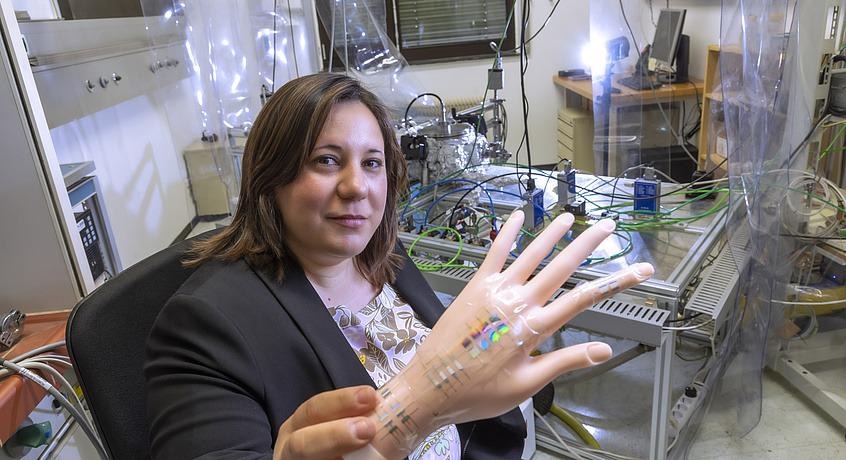The skin is not only the largest sensory organ but also the protective covering of human beings. It “feels” numerous sensory inputs simultaneously and reports information concerning temperature, humidity and pressure to the brain.
 Anna Maria Coclite from TU Graz and her team have succeeded in producing a 3in1 hybrid material for the next generation of smart, artificial skin. Image Credit: © Lunghammer - TU Graz.
Anna Maria Coclite from TU Graz and her team have succeeded in producing a 3in1 hybrid material for the next generation of smart, artificial skin. Image Credit: © Lunghammer - TU Graz.
For Anna Maria Coclite, the ERC grant winner and scientist at the Institute of Solid State Physics at TU Graz, a material with such multisensory characteristics is “a kind of ‘holy grail’ in the technology of intelligent artificial materials. In particular, robotics and smart prosthetics would benefit from a better integrated, more precise sensing system similar to human skin.”
The TU Graz researcher has been successful in building the three-in-one hybrid material “smart skin” using an innovative process. The result of this groundbreaking research has currently been reported in the journal Advanced Materials Technologies.
As Delicate as a Fingertip
For nearly 6 years, a team of researchers has been involved in the creation of smart skin as part of Coclite’s ERC project Smart Core. The hybrid material contains 2,000 individual sensors per square millimeter, making it even more sensitive than a human fingertip. Each of these sensors contains an exclusive combination of materials: on the inside, a smart polymer in the form of a hydrogel and on the outside, a shell of piezoelectric zinc oxide.
The hydrogel can absorb water and thus expands upon changes in humidity and temperature. In doing so, it exerts pressure on the piezoelectric zinc oxide, which responds to this and all other mechanical stresses with an electrical signal.
Anna Maria Coclite, Study Lead and Scientist, Institute of Solid State Physics, TU Graz
The outcome is a wafer-thin material that reacts instantaneously to moisture, force and temperature with very high spatial resolution and discharges corresponding electronic signals.
The first artificial skin samples are six micrometres thin, or 0.006 millimetres. But it could be even thinner.
Anna Maria Coclite, Study Lead and Scientist, Institute of Solid State Physics, TU Graz
In contrast, the human epidermis measures 0.03 to 2 mm in thickness.
The human skin is capable of perceiving things from a size of approximately 1 mm2. The smart skin comprises a resolution that is a thousand times smaller and can record objects that are too small for human skin (like microorganisms).
Material Processing at the Nanoscale
Each sensor layer is very thin and simultaneously fitted with sensor elements covering the whole surface. For the first time, this was possible in an internationally exclusive process for which the scientists integrated three known techniques from physical chemistry: a chemical vapor deposition for the hydrogel material, nanoprint lithography for the polymer template, and an atomic layer deposition for the zinc oxide.
The lithographic preparation of the polymer template was the duty of the research group “Hybrid electronics and structuring” guided by Barbara Stadlober. The group belongs to Joanneum Research’s Materials Institute situated in Weiz.
There are numerous fields of application for this skin-like hybrid material. In healthcare, for instance, the sensor material could autonomously perceive microorganisms and communicate data about them accordingly.
Furthermore, it could be feasible to create prostheses that inform the wearer information about humidity or temperature, or robots that can sense their surroundings more sensitively. On the route to application, smart skin scores with a critical benefit: the sensory nanorods — the “smart core” of the material — are created using a vapor-based engineering process.
This process is already proven in, for example, production units for integrated circuits. The manufacture of smart skin can thus be effortlessly scaled and executed in present production lines.
The smart skin’s properties are currently being enhanced even further. Anna Maria Coclite and her team — especially Ph.D. student Taher Abu Ali — are keen to extend the temperature range to which the material reacts and enhance the flexibility of the synthetic skin.
Journal Reference:
Ali, T. A., et al. (2022) Smart Core-Shell Nanostructures for Force, Humidity and Temperature Multi-Stimuli Responsiveness. Advanced Materials Technologies. doi.org/10.1002/admt.202200246.